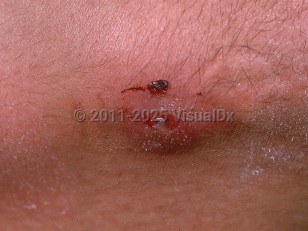Neurothekeoma
Alerts and Notices
Important News & Links
Synopsis

Neurothekeoma is a rare, benign tumor of unclear etiology; previously a neural derivation was favored, but more recent studies favor a more fibroblastic / fibrohistiocytic origin.
It most commonly presents in the second decade of life and has a female predilection. It typically presents as a firm, pink-tan or red-brown, dome-shaped papule or nodule. Common locations are the head, arms, and shoulder girdles. Neurothekeomas are slow growing and typically asymptomatic but can cause pain with pressure.
Neurothekeomas are often classified histologically into myxoid, cellular, or mixed type. Of note, in the past, nerve sheath myxomas were often included within the myxoid subtype of neurothekeomas. However, recent studies have shown that nerve sheath myxomas are a distinct and separate clinical entity.
Pediatric Patient Considerations:
Neurokethomas can be seen as dermal nodules in infants and children.
It most commonly presents in the second decade of life and has a female predilection. It typically presents as a firm, pink-tan or red-brown, dome-shaped papule or nodule. Common locations are the head, arms, and shoulder girdles. Neurothekeomas are slow growing and typically asymptomatic but can cause pain with pressure.
Neurothekeomas are often classified histologically into myxoid, cellular, or mixed type. Of note, in the past, nerve sheath myxomas were often included within the myxoid subtype of neurothekeomas. However, recent studies have shown that nerve sheath myxomas are a distinct and separate clinical entity.
Pediatric Patient Considerations:
Neurokethomas can be seen as dermal nodules in infants and children.
Codes
ICD10CM:
D36.10 – Benign neoplasm of peripheral nerves and autonomic nervous system, unspecified
SNOMEDCT:
51836001 – Neurothekeoma
D36.10 – Benign neoplasm of peripheral nerves and autonomic nervous system, unspecified
SNOMEDCT:
51836001 – Neurothekeoma
Look For
Subscription Required
Diagnostic Pearls
Subscription Required
Differential Diagnosis & Pitfalls

To perform a comparison, select diagnoses from the classic differential
Subscription Required
Best Tests
Subscription Required
Management Pearls
Subscription Required
Therapy
Subscription Required
References
Subscription Required
Last Reviewed:11/19/2017
Last Updated:12/05/2017
Last Updated:12/05/2017
Neurothekeoma

